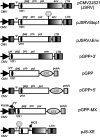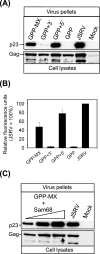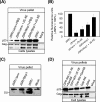Expression of the jaagsiekte sheep retrovirus envelope glycoprotein is sufficient to induce lung tumors in sheep
- PMID: 16873259
- PMCID: PMC1563803
- DOI: 10.1128/JVI.00474-06
Expression of the jaagsiekte sheep retrovirus envelope glycoprotein is sufficient to induce lung tumors in sheep
Abstract
Jaagsiekte sheep retrovirus (JSRV) is the causative agent of ovine pulmonary adenocarcinoma (OPA). The expression of the JSRV envelope (Env) alone is sufficient to transform a variety of cell lines in vitro and induce lung cancer in immunodeficient mice. In order to determine the role of the JSRV Env in OPA tumorigenesis in sheep, we derived a JSRV replication-defective virus (JS-RD) which expresses env under the control of its own long terminal repeat (LTR). JS-RD was produced by transiently transfecting 293T cells with a two plasmid system, involving (i) a packaging plasmid, with the putative JSRV packaging signal deleted, expressing the structural and enzymatic proteins Gag, Pro, and Pol, and (ii) a plasmid which expresses env in trans for JS-RD particles and provides the genomes necessary to deliver JSRV env upon infection. During the optimization of the JS-RD system we determined that both R-U5 (in the viral 5' LTR) and the env region are important for JSRV particle production. Two independent experimental transmission studies were carried out with newborn lambs. Four of five lambs inoculated with JS-RD showed OPA lesions in the lungs at various times between 4 and 12 months postinoculation. Abundant expression of JSRV Env was detected in tumor cells of JS-RD-infected animals and PCR assays confirmed the presence of the deleted JS-RD genome. These data strongly suggest that the JSRV Env functions as a dominant oncoprotein in the natural immunocompetent host and that JSRV can induce OPA in the absence of viral spread.
Figures





Similar articles
-
Lung cancer induced in mice by the envelope protein of jaagsiekte sheep retrovirus (JSRV) closely resembles lung cancer in sheep infected with JSRV.Retrovirology. 2006 Dec 19;3:94. doi: 10.1186/1742-4690-3-94. Retrovirology. 2006. PMID: 17177996 Free PMC article.
-
Jaagsiekte sheep retrovirus detected in human lung cancer tissue arrays.BMC Res Notes. 2014 Mar 19;7:160. doi: 10.1186/1756-0500-7-160. BMC Res Notes. 2014. PMID: 24642139 Free PMC article.
-
Detection of Jaagsiekte sheep retrovirus in the peripheral blood during the pre-clinical period of ovine pulmonary adenomatosis.Genet Mol Res. 2016 Aug 29;15(3). doi: 10.4238/gmr.15038521. Genet Mol Res. 2016. PMID: 27706644
-
Pathology and pathogenesis of ovine pulmonary adenocarcinoma.J Comp Pathol. 2010 May;142(4):260-83. doi: 10.1016/j.jcpa.2009.12.013. Epub 2010 Feb 16. J Comp Pathol. 2010. PMID: 20163805 Review.
-
Oncogenic transformation by the jaagsiekte sheep retrovirus envelope protein.Oncogene. 2007 Feb 8;26(6):789-801. doi: 10.1038/sj.onc.1209850. Epub 2006 Aug 14. Oncogene. 2007. PMID: 16909114 Review.
Cited by
-
Jaagsiekte sheep retrovirus infection of lung slice cultures.Retrovirology. 2015 Apr 9;12:31. doi: 10.1186/s12977-015-0157-5. Retrovirology. 2015. PMID: 25889156 Free PMC article.
-
Structural and functional comparisons of retroviral envelope protein C-terminal domains: still much to learn.Viruses. 2014 Jan 16;6(1):284-300. doi: 10.3390/v6010284. Viruses. 2014. PMID: 24441863 Free PMC article. Review.
-
Enzootic nasal tumor virus envelope requires a very acidic pH for fusion activation and infection.J Virol. 2008 Sep;82(18):9023-34. doi: 10.1128/JVI.00648-08. Epub 2008 Jul 16. J Virol. 2008. PMID: 18632865 Free PMC article.
-
Exploiting ovine immunology to improve the relevance of biomedical models.Mol Immunol. 2015 Jul;66(1):68-77. doi: 10.1016/j.molimm.2014.09.002. Epub 2014 Sep 26. Mol Immunol. 2015. PMID: 25263932 Free PMC article.
-
"Ménage à Trois": the evolutionary interplay between JSRV, enJSRVs and domestic sheep.Viruses. 2014 Dec 9;6(12):4926-45. doi: 10.3390/v6124926. Viruses. 2014. PMID: 25502326 Free PMC article. Review.
References
-
- Allen, T. E., K. J. Sherrill, S. M. Crispell, M. R. Perrott, J. O. Carlson, and J. C. DeMartini. 2002. The jaagsiekte sheep retrovirus envelope gene induces transformation of the avian fibroblast cell line DF-1 but does not require a conserved SH2 binding domain. J. Gen. Virol. 83:2733-2742. - PubMed
-
- Ausbel, F. M., R. Brent, R. E. Kingston, D. D. Moore, J. G. Seidman, J. A. Smith, and K. Struhl (ed.). 2000. Current protocols in molecular biology. John Wiley and Son, New York, N.Y.
-
- Berns, A. 2005. Stem cells for lung cancer? Cell 121:811-813. - PubMed
-
- Brown, P. O. 1997. Integration, p. 161-203. In J. M. Coffin, S. H. Hughes, and H. E. Varmus (ed.), Retroviruses. Cold Spring Harbor Laboratory Press, Cold Spring Harbor, N.Y.
Publication types
MeSH terms
Substances
Grants and funding
LinkOut - more resources
Full Text Sources
Medical
Molecular Biology Databases
Miscellaneous

